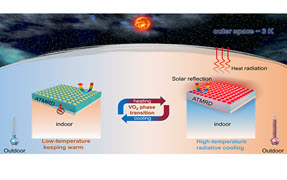Storing light in optical fibers using sound waves
Increasing traffic on the Internet demands faster optical transmission networks. Future high-speed communication networks may rely largely on all-optical components that are intrinsically faster than their electronic counterparts. To achieve such networks, however, one needs to overcome a number of obstacles that exist at levels from devices to systems. For example, the lack of all-optical memory for storing optical data remains a bottleneck in modern optical information networks.1 There has been substantial progress in addressing this problem using spatial-spectral holography in systems that operate at cryogenic temperatures2 or stored light based on electromagnetically induced transparency, where optical information is impressed upon internal degrees of freedom of an ensemble of atoms or ions.3 Both of these methods, however, are limited to operating at the resonance wavelength of the ions or atoms used. These limitations have recently been partially overcome using a dynamically controlled resonator in which a single optical pulse was stored for ∼100ps.4

We recently presented a different approach: a simple stored-light approach5 in which optical pulse information is transferred onto a slowly moving hypersonic wave (∼1/40,000 of the light speed) in an optical fiber and converted back at a later time through stimulated Brillouin scattering (SBS) as illustrated in Figure 1. In the storage process, optical data pulses (of carrier frequency ν0) interact with a counterpropagating short intense ‘write’ pulse (of carrier frequency ν0+νB, where νB is the Brillouin frequency shift of the fiber). The optical data pulses become depleted as energy is shifted to a hypersonic wave in the fiber. In the retrieval process, a short intense ‘read’ pulse at the same frequency as the ‘write’ pulse depletes the acoustic wave and releases the data back to the original optical frequency, thereby generating a replica of the incident data pulses. This stored-light approach has advantages such as room-temperature operation at any wavelength within the fiber transparency window, and the use of off-the-shelf components.
Our stored-light approach can obtain high storage and retrieval efficiency when four conditions are satisfied.5 The first condition is that the ‘area’ of the write and read pulses must equal π/2, which determines the peak power requirement for these pulses. Another condition is that the write and read pulses must be shorter than the shortest-duration data pulse in order to achieve faithful storage and retrieval of data pulses. Third, the storage time Ts (the time separation between the write and read pulses) must be less the acoustic lifetime τB, because the exponential decay of the acoustic wave reduces the readout efficiency until the data is eventually lost. Finally, the spatial extent of the data packet must be less than twice the length of the storage material.
In our recent experiment,5 we used two 1.55μm tunable diode lasers to create the write, read, and data pulses and used a 5m-long highly-nonlinear fiber (with a νB∼9.6GHz and τB∼3.4ns) as the medium for storing light. We cascaded several erbium-doped fiber amplifiers to obtain 1.5ns-long write and read pulses with the required peak powers of ∼100W. The system stored 2ns-long data pulses for up to 12ns with good readout efficiency, and demonstrated the potential of our approach for storing data packets that contain many pulses.

Figure 2(a) shows results for storing and retrieving a single rectangular-shaped 2ns data pulse. (The incident data pulse is shown to the left of the dashed vertical line by the blue line.) About 66% of the incident pulse energy is depleted in the storage process, indicating a faithful transfer of optical pulse information onto the acoustic wave. The curves to the right of the dashed vertical line are the retrieved pulses for various Ts, which are scaled by a factor of two for clarity. The readout efficiency (defined as the ratio of the energy of the released pulse to that of the incident data pulse) is 25% for Ts = 4ns, and 1.8% for Ts = 12ns. As expected, the readout efficiency drops with increasing storage time due to the decay of the acoustic wave. We also stored and retrieved a smoothed-edge 2ns data pulse—Figure 2(b)—for which the energy storage efficiency increases to 86% and the readout efficiencies are improved slightly (∼29% for Ts = 4ns, ∼2% for Ts=12ns).
Figures 3(a) and 3(b) show our observations for the storage and retrieval of sequences of two and three data pulses, respectively. For clarity, we show only the input data pulses to the left of the dashed vertical line, and to the right we show the retrieved pulses scaled by a factor of five. The retrieved light replicates the input data stream with reasonable fidelity.

In summary, we demonstrated a simple approach for coherent light storage which allows us to store 2ns pulses for up to 12ns in an optical fiber with reasonable retrieval efficiencies. This stored-light technique can be improved by using fibers that exhibit longer acoustic lifetime (which will allow longer storage time and higher retrieval efficiency) and higher Brillouin sensitivity (which would reduce the peak power requirements of the write and read pulses). We anticipate that our method will be useful in all-optical memories and information processing such as correlation and convolution.
We gratefully acknowledge the financial support from the DARPA DSO Slow-Light Program.



